Armenian Gulls at Lake Sevan
May 2018
Armenian Gulls at Lake Sevan
|
|
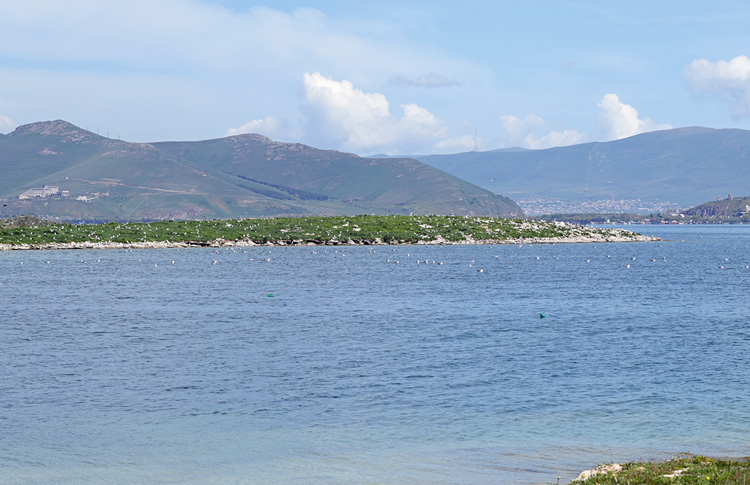
© A. R. Dean
Plate 1.'Gull Island', at northern end of Lake Sevan, Armenia, May 2018
Armenian Gull Larus armenicus has a limited breeding distribution, based in the Caucasian region around Armenia, Georgia and NW Iran, with outposts in western and central Turkey. It was first described by Buturlin in 1934, from Lake Sevan in Armenia. It winters south to the coasts of the E Mediterranean, the N Red Sea and the N Persian Gulf (HBW Alive). The European population is estimated at between 19000 and 29000 pairs. Populations at its breeding sites have oscillated over the years and, while they have increased substantially from historical lows between the 1930s and 1960s, the global population is thought to be declining currently at a moderately rapid rate, approaching 30% in three generations (BirdLife International Data Zone). Together with its limited distribution, this has led to its classification as 'Near Threatened' (IUCN).
Most European observers encounter Armenian Gulls in their winter quarters, especially Israel (e.g. at Maagan Michael). Observations from their breeding sites remain relatively limited. For a summary of past research and what is currently known, see the Gull Research Organisation web-pages on Armenian Gull, which include on-line versions of papers including 'The Armenian Gull in Armenia' by A. V. Filchagov, first published in British Birds in 1993, and 'Phenotypic characterization, taxonomic rank and phylogenetic relationships of Armenian Gull Larus armenicus' by D. Liebers & A. J. Helbig, published in Limicola in 1999.
The following annotated photographs result from a visit to Lake Sevan and its surroundings on May 18th & 19th, 2018, during a Zoothera-organised tour to Armenia.
Plate 1 (header image) shows 'Gull Island', one of the principal breeding sites at the northern end of Lake Sevan. The island is readily visible from the lake's shore, where good numbers of gulls are also to be found feeding and loafing. Nevertheless, boats go out to the island and it certainly gave the impression of being 'too easily accessible' by human visitors and vulnerable to disturbance.

© A. R. Dean
Plate 2. 'Gull Island', Lake Sevan, May 2018.
Most gulls were breeding in low vegetation around the margins of the island, with the upper, bush-clad rocky areas dominated by Cormorants.

© A. R. Dean
Plate 3. 'Gull Island', Lake Sevan, May 2018
The Armenian Gulls appeared to be breeding at quite high density, with gulls
sitting and standing relatively close to one another and exhibiting 'conspecific
tolerance'.
This is in accordance with the observations of Filchagov (1993).
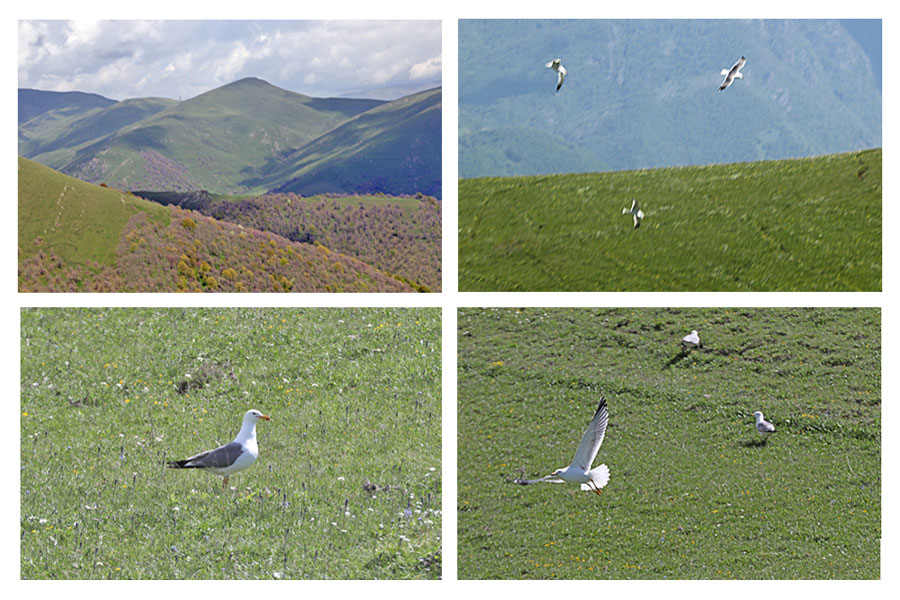
© A. R. Dean
Plate 4. High-altitude loafing site near Pambak, in mountains above Lake Sevan,
Lake Sevan lies at about 1900 m asl and Armenian Gulls are associated with
mountain lakes. Nevertheless, in the Pambak area on May 18th it seemed
incongruous to find an assembly
of 100 or more Armenian Gulls loafing in
high-altitude meadows, on the slopes of mountains which reach an altitude of over
3000m. The lake was visible way below the loafing area.
Other species encountered in this general area included montane species such as Caucasian
Black Grouse, Rufous-tailed Rock Thrush and Horned Lark.

© A. R. Dean
Plate 5. Adult Armenian Gull in meadows high above Lake Sevan.
Adult Armenian Gull in Pambak area. Mantle shade rather darker than
Yellow-legged Gull (armenicus is given by Olsen (2018) as Kodak Grey
Scale 7 - 8.5 c.f. 5- 7 for michahellis).
Dark iris and black band
towards bill-tip are characteristic. Probably a male, with a long
and rather bulbous-tipped bill, not exhibiting the somewhat stubby and 'blunt-tipped' appearance
frequently attributed to the species. As noted by Olsen (2018), many male
Armenian Gulls have heavy and broad-tipped bills while
Filchagov
(1993) speculated that the
'traditional' image may be female-biased. Bill tip in
plate 5 is nevertheless less pointed than in many barabensis, which are very
close in appearance to armenicus (see caption to plate 10).
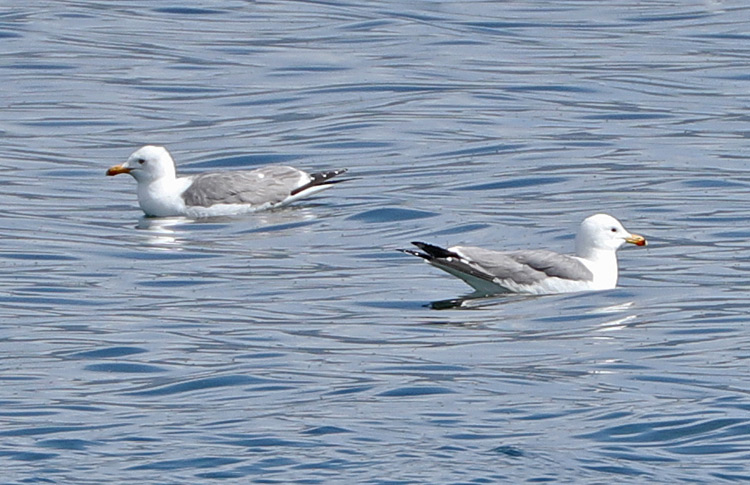
© A. R. Dean
Plate 6. Two adults with shape and demeanour close to traditional image : rounded head-shape and bills looking rather stubby and blunt-tipped. Perhaps females.

© A. R. Dean
Plate 7. Adult at Lake Sevan.
A typical adult, with dark-grey mantle, bright yellow legs, dark iris and 'four-coloured' bill (ivory at extreme tip of 'nail', black band subterminally, red spot on gonys and rich yellow base).
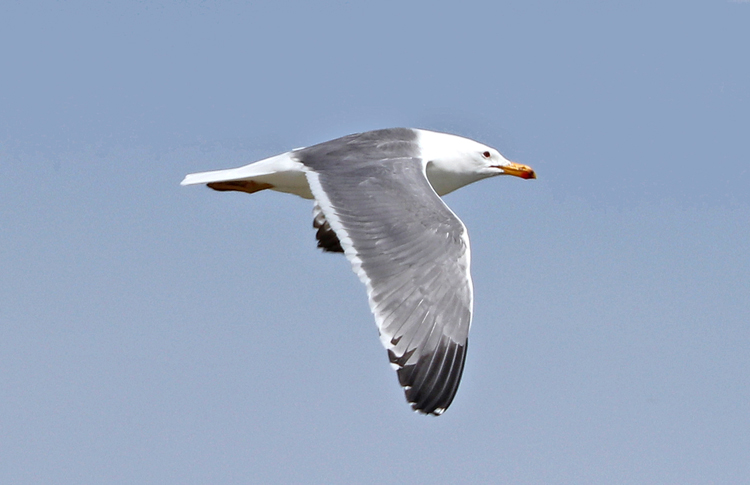
© A. R. Dean
Plate 8. Adult in flight. Lake Sevan.
Black on primaries extending to p4 and reaching down to primary coverts on p8 -
p10. The area of black appears 'solid' and rather 'square-cut' across the centre
of the 'hand'.
However, see Plates 10 & 10a. A single relatively small white mirror
on p10 is normal, with some individuals having a rudimentary mirror on p9.
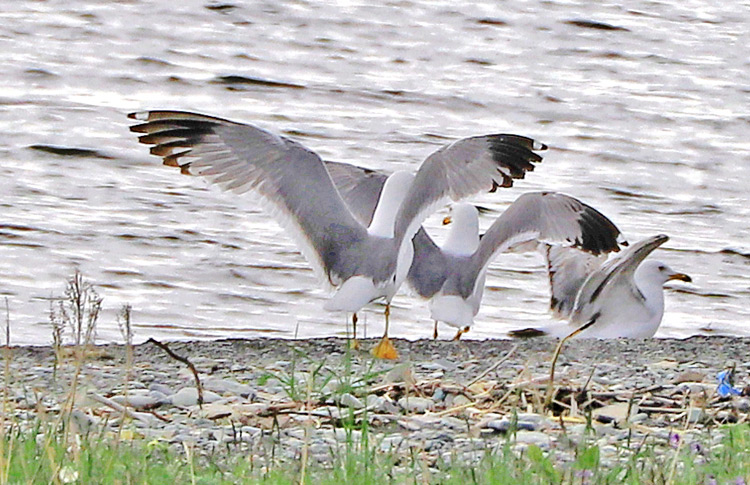
© A. R. Dean
Plate 9. Upperwing primary patterns of adult and possible 5cy / fourth-summer (left-hand and central birds, respectively, with 3cy to right).
Note again the extensive and rather 'square-cut' area of black on the primaries. On central bird black streaks on primary coverts and alula, suggest a gull in its fourth summer.
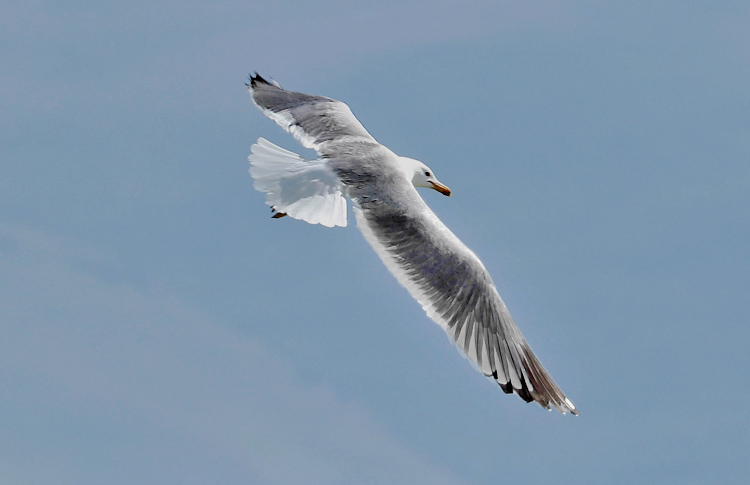
© A. R. Dean
Plate 10. Upperwing pattern of adult, with outer primaries partially spread.
The extent of black on the outer primaries of Armenian Gull exceeds that of
other LWHGs. It is said to lack the whitish 'tongues' on the inner webs
of the
outer and central primaries which differentiate Steppe Gull (barabensis)
e.g. Olsen & Larsson (2003). However, note here how bright light
and translucency can combine to
produce quite extensive 'pale' areas on the central (and inner) primaries when these
feathers are well-spread.
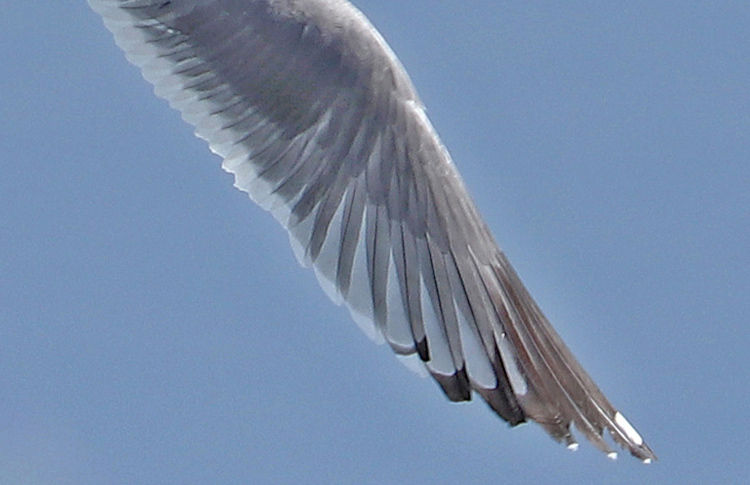
© A. R. Dean
Plate 10a. Detail of primary pattern of adult, with strong back-lighting.
Compare this photo with that by Jem Babbingon showing spread wing of barabensis in Saudia Arabia.
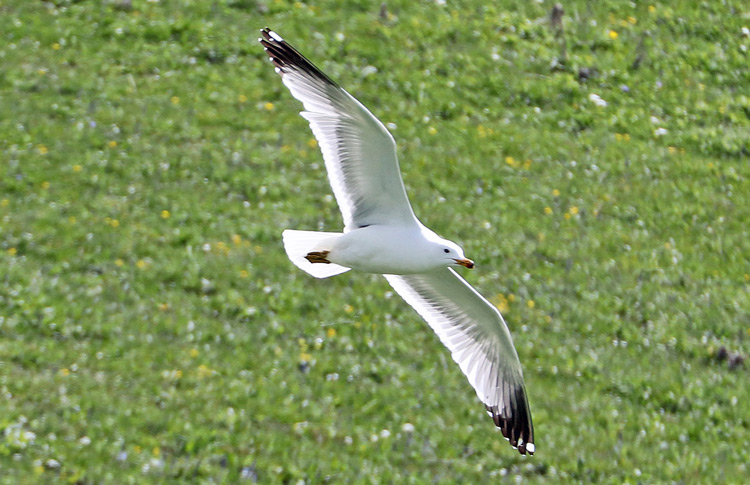
© A. R. Dean
Plate 11. Underwing pattern of adult or near-adult. Pambak area.
Moult in progress, with new p1 and p2 part-grown on right wing. This may suggest a 'sub-adult', as full adults do not usually commence primary moult until July, a month later than in e.g. Yellow-legged Gull (Olsen & Larsson 2003).

© A. R. Dean
Plate 12. Iris and bill-pattern of adult.
The bill of this individual appears close to the 'traditional' image, appearing
rather stubby and blunt-tipped. The head is turned slightly towards the camera,
however,
which will produce some fore-shortening. The red spot on the bill of this individual is confined to the lower mandible but in others
may extend partially onto the upper mandible.
Here the black band is clear-cut
on the upper mandible but becomes diffuse on the lower mandible and fades out
towards the base of the gonys. All individuals seen clearly
exhibited black on the
bill. This was still a very small sample of the total number of gulls
present but accords with the findings of Filchagov (1993) in his study at Lake Sevan,
who reported that, of 51 individuals examined carefully, 33 (64.7%)
exhibited an unbroken black band on the upper mandible and a spot on the lower
mandible while on
16 (31.4%) there was a dark spot confined to the upper
mandible. Only two lacked black entirely. (The statement by Olsen (2018) that : 'In summer, dark bill markings present
in 83% in E Turkey, down to 5% in
populations from Armenia' seems likely to be a misprint, as the figures quoted
by Olsen & Larsson (2003) mirror those of Filchagov.)
In the adult in plate 12,
the iris appears dark, with a dark red orbital ring but the enlarged view
indicates a dull yellow but well-peppered iris. Iris
colour in Armenian Gull varies
from brown to yellow, with a variable amount of
dark 'peppering'.
Liebers & Helbig (1999) reported that, at their study sites in Turkey, the
iris was pale in 14% and dark in 44%
with the remainder exhibiting all levels of
variation in-between. An article on
iris
colour in individuals wintering in Israel can be found on the Gull Research
Organisation website.
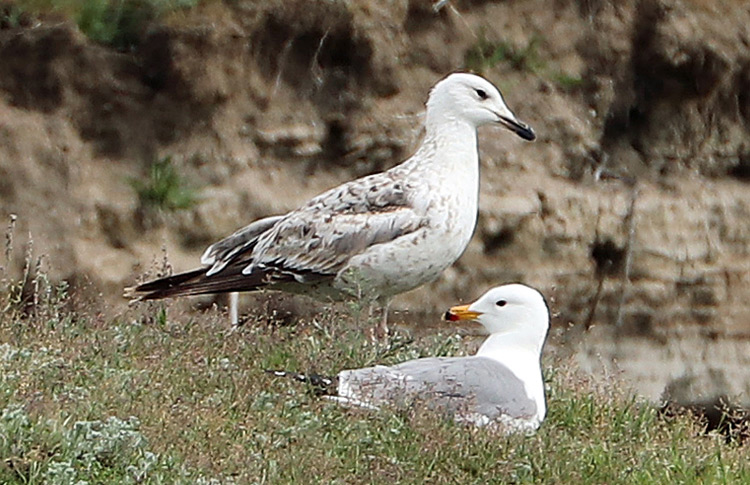
© A. R. Dean
Plate 13. 2cy / first-summer (standing, with adult sitting to right). Lichk, May 2018.
Head and fore-neck quite white, with dark streaking confined to hind-neck.
Flanks quite heavily marked. Upperparts a mixture of second-generation
and
juvenile feathers, with worn juvenile coverts conspicuously pale and faded. At
least in this posture, the head appears quite small and with extended
maxillary
feathering, thus not too dissimilar to Caspian Gull. The tip of the bill is
somewhat more blunt and bulbous than typical of cachinnans.
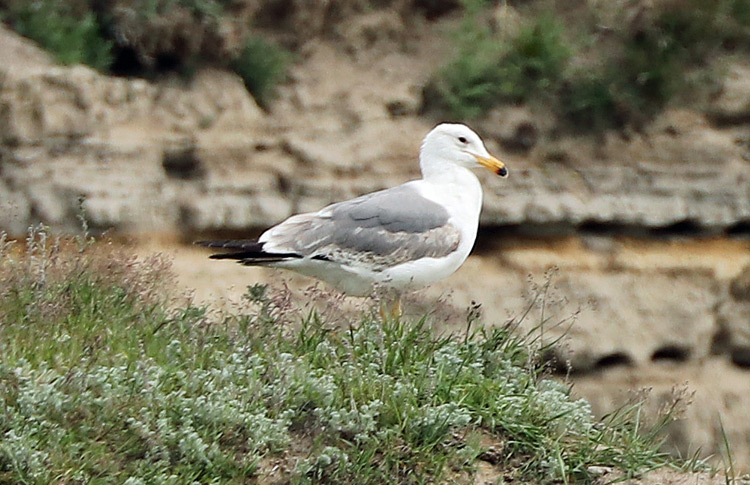
© A. R. Dean
Plate 14. 3cy / second-summer at rest. Lichk, May 2018.
Clean dark grey
saddle and inner greater coverts. Head and bill quite adult-like but black at
bill-tip much more extensive.
Another large and bulky-looking individual, with a relatively flat-topped crown
and a powerful bill.
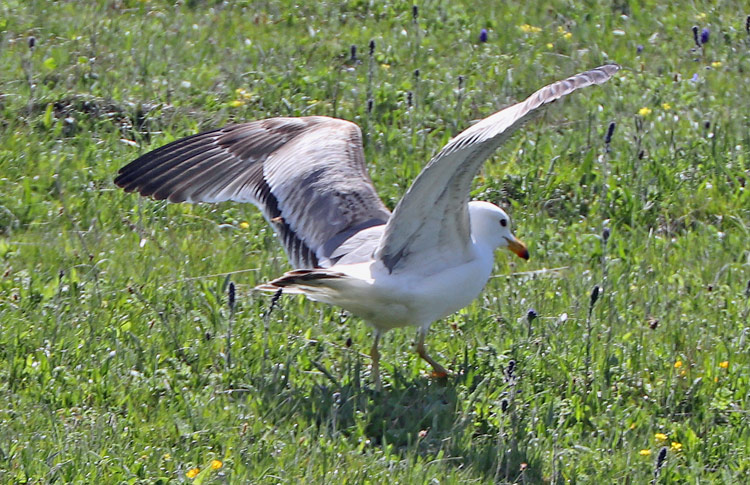
© A. R. Dean
Plate 15. 3cy / second-summer : upperwing. Pambak area.
Grey mantle and inner greater coverts contrast with retained lesser and median
coverts. Axillaries and under wing coverts extensively white
but dusky tips to latter creating sullying. Underbody, head and bare-parts
well-advanced towards adult appearance.
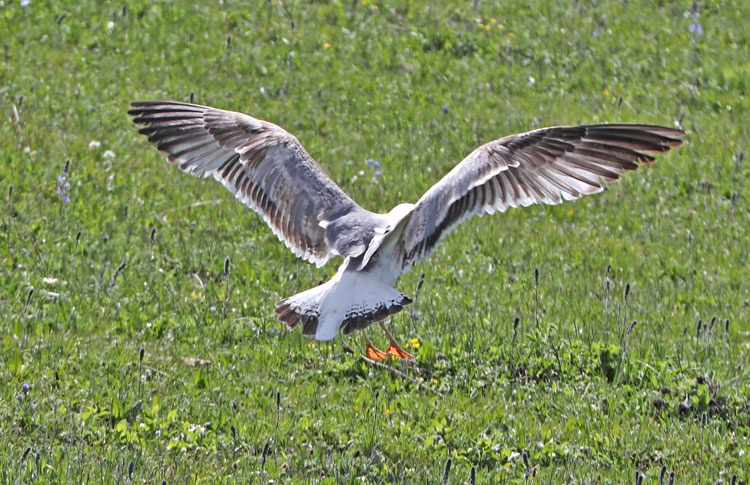
© A. R. Dean
Plate 16. 3cy / second-summer. Pambak area.
Prominent tail-band on outer feathers (with spotted and barred interior but white base) but central tail-feathers replaced with clean white adult-like feathers.

© A. R. Dean
Plate 17. 3cy / second-summer : underwing in flight. Lichk, May 2018.
Extensive dark barring and sullying on lesser coverts and
primary coverts, with underwing in general contrasting with very white underbody.
Inner primaries in moult in mid-May, typical for this age (e.g. Olsen 2018).
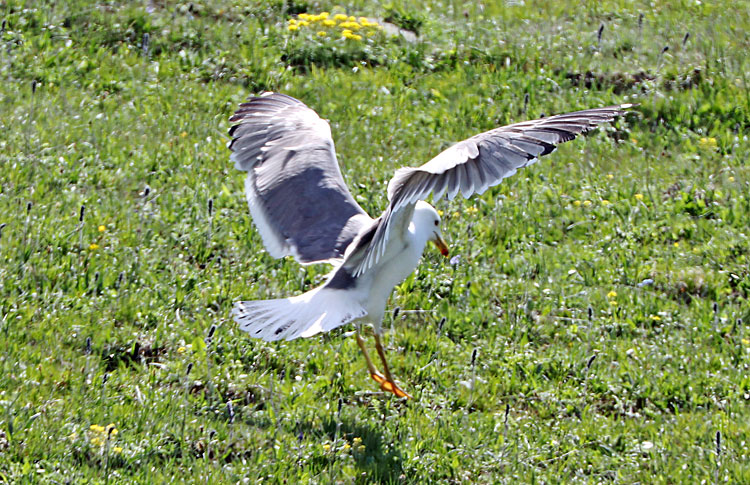
© A. R. Dean
Plate 18. 4cy / third-summer. Pambak area.
Quite adult-like overall but remnants of tail-band indicate 4cy / third-summer.
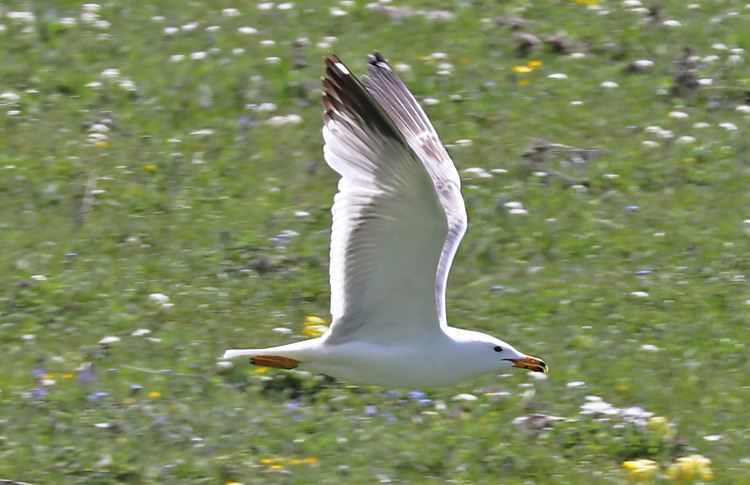
© A. R. Dean
Plate 19. 5cy / fourth-summer type. Pambak area.
Dark streaks on primary coverts and onset of primary moult in mid-May suggest fourth-summer individual.
BirdLife International 2017. Larus armenicus (amended version of 2016 assessment). The IUCN Red List of Threatened Species 2017: e.T22694357A112467763. http://dx.doi.org/10.2305/IUCN.UK.2017-1.RLTS.T22694357A112467763.e. Downloaded on 29 June 2018.
Burger, J., Gochfeld, M., Sharpe, C.J. & Garcia, E.F.J. 2018. Armenian Gull (Larus armenicus). In: del Hoyo, J., Elliott, A., Sargatal, J., Christie, D.A. & de Juana, E. (eds.). Handbook of the Birds of the World Alive. Lynx Edicions, Barcelona. (retrieved from https://www.hbw.com/node/53984 on 29 June 2018).
Filchagov, A.V. 1993. The Armenian Gull in Armenia. British Birds 86: 550-560.
Gull Research Organisation : Armenian Gull. http://www.gull-research.org/armenicus/05cyaug.html
Liebers, D. & Helbig, A. J. 1999. Phenotypic characterization, taxonomic rank and phylogenetic relationships of Armenian Gull Larus armenicus. Limicola 13 - 6.
Olsen, K. M. 2018. Gulls of the World : A photographic Guide. London.
Olsen, K. M. & Larsson, H. 2003. Gulls of Europe, Asia and North America. London.
|
|